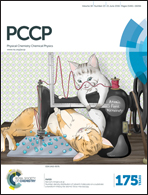Electrochemical and photophysical behavior of 1-naphthol in benzyl-n-hexadecyldimethylammonium 1,4-bis(2-ethylhexyl)sulfosuccinate large unilamellar vesicles
Abstract
In the present contribution, 1-naphthol is investigated in large unilamellar vesicles formed from a new catanionic surfactant, benzyl-n-hexadecyldimethylammonium 1,4-bis(2-ethylhexyl)sulfosuccinate, by electrochemical and spectroscopic techniques. The electrochemical results show that 1-naphthol experiences a partition process between the water phase and the large unilamellar vesicle bilayer phase, which is corroborated by absorption spectroscopic studies at pH = 6.40 and pH = 10.75. Interestingly, studies of 1-naphthol emission in benzyl-n-hexadecyldimethylammonium 1,4-bis(2-ethylhexyl)sulfosuccinate large unilamellar vesicles at pH = 10.75 and in sodium 1,4-bis(2-ethylhexyl)sulfosuccinate water solution show that when the 1,4-bis(2-ethylhexyl)sulfosuccinate moiety is part of the bilayer, the 1,4-bis(2-ethylhexyl)sulfosuccinate polar head interacts strongly with 1-naphthol, by favoring emission from the excited neutral species resulting in the appearance of a new band close to λ = 355 nm. It seems that the large unilamellar vesicle bilayer of the catanionic vesicle slows down the proton transfer process observed in water, where only emission from 1-naphtholate is detected.


 Please wait while we load your content...
Please wait while we load your content...